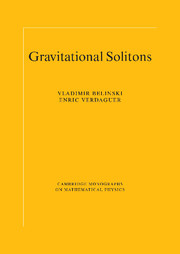Book contents
- Frontmatter
- Contents
- Preface
- 1 Inverse scattering technique in gravity
- 2 General properties of gravitational solitons
- 3 Einstein–Maxwell fields
- 4 Cosmology: diagonal metrics from Kasner
- 5 Cosmology: nondiagonal metrics and perturbed FLRW
- 6 Cylindrical symmetry
- 7 Plane waves and colliding plane waves
- 8 Axial symmetry
- Bibliography
- Index
3 - Einstein–Maxwell fields
Published online by Cambridge University Press: 17 August 2009
- Frontmatter
- Contents
- Preface
- 1 Inverse scattering technique in gravity
- 2 General properties of gravitational solitons
- 3 Einstein–Maxwell fields
- 4 Cosmology: diagonal metrics from Kasner
- 5 Cosmology: nondiagonal metrics and perturbed FLRW
- 6 Cylindrical symmetry
- 7 Plane waves and colliding plane waves
- 8 Axial symmetry
- Bibliography
- Index
Summary
The purpose of this chapter is to describe the integration scheme for Einstein– Maxwell equations. We begin in section 3.1 by writing the Einstein–Maxwell equations in a suitable form when the spacetime admits, as in chapter 1, an orthogonally transitive two-parameter group of isometries. We then formulate in section 3.2 the corresponding spectral equations which take in this case the form of 3×3 matrix equations. It turns out that one cannot simply generalize the procedure of chapter 1, since some extra constraints have to be imposed on the linear spectral equations to be able to reproduce the Einstein–Maxwell equations as integrability conditions of such linear equations. In sections 3.3 and 3.4 we show how these problems can be overcome and the n-soliton solution can be constructed. Because the procedure is rather involved we formulate the basic steps in a recipe of 11 points which should be useful for practical calculations. Finally in section 3.5, as an illustration of the procedure given, the analogue of the sine-Gordon breather in the Einstein–Maxwell context is deduced and briefly described.
The Einstein–Maxwell field equations
In sections 1.2–1.4 we established the complete integrability of Einstein equations in vacuum for the metric (1.36) by means of the ISM, and the same will be done for the stationary analogue of this metric in chapter 8. However, the inclusion of matter, i.e. the appearance of a nonzero right hand side in the Einstein equations, generally destroys the applicability of the ISM.
- Type
- Chapter
- Information
- Gravitational Solitons , pp. 60 - 91Publisher: Cambridge University PressPrint publication year: 2001



